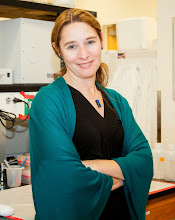Calling all science fans (nerds, closet nerds, hipsters, etc.) living in the Seattle area...want to hear about some great cutting-edge science in an understandable way? The University of Washington Engage Science speakers series features UW researchers talking about their work in an informal evening setting. This year's series kicks off on Wednesday, Feb. 2nd at 7 PM with an astronomy presentation that's sure to please.
Charlotte's talk will be in Johnson Hall, Room 075, UW Seattle Campus. Come learn how stars are born!
Speaking about Science...the blog about how to communicate scientific concepts to the public, and to other scientists, and about why we should care.
About Me

- Allison Coffin, PhD, DTM
- I'm an assistant professor of neuroscience at Washington State University in Vancouver, where I use tiny zebrafish (the size of an eyelash!) as a model system to study human hearing loss and how we can prevent it. I'm also a long-time Toastmaster and I teach communication workshops. This blog represents the merging of my two passions - science and communication, which has really become one central passion - the science of communication. There's a revolution in science right now...the idea that we scientists should sometimes leave the lab and talk about what we do, and why we do it, to real people. This blog looks at why we should do this, and how to actually talk about science with non-scientists (and with each other!). Portions of this blog are also featured on Qualia, the AAAS MemberCenter blog site.
Sunday, January 30, 2011
Monday, January 24, 2011
Scientific Characters
In a previous post I introduced the idea of telling stories within a scientific talk - using techniques such as plot, character development, climax, and resolution to make science (and scientists!) come alive.
Today I want to highlight a recent example of a terrific scientist who also tells a great story. A few months ago I attended a talk by Dr. Douglas Green from St. Jude Children’s Research Hospital. Doug studies the intricacies of cell death signaling, which can be a bit of a dry subject even to the aficionado. This was a lunchtime seminar full of cancer researchers, neuroscientists…in short, serious researchers prepared to dive in to the topic. And then Doug told us a story, complete with characters, conflict, and (perhaps) resolution.
This was no bedtime story, though. Embedded within the story was some serious science, as two groups of researchers presented different models for how specific cell death signaling molecules interact to promote cell death or survival. Doug described the tension at meetings as each group presented evidence for their model and tried to discredit the other side. After hearing about the conflict I was eager for a resolution-which group was right? He then led us through data from his lab that, depending on the circumstances, partially supported each model, and told of the triumph as each research group in the conflict gloated and sulked in turn.
At the end of the hour I had a deeper understanding of cell death signaling without the usual post-talk sleepiness I often feel. Instead, I was energized, having learned a lot and been entertained at the same time. Even in a room full of scientists, it’s best to tell a story. Have you heard great examples of scientists that use storytelling elements? Share your story with us!
This blog post also appears on Qualia, part of AAAS MemberCentral.
Subscribe to:
Comments (Atom)
